
The most important research achievements:
1. Zero-field
optically induced magnetization in CdMnTe QDs.
2. Spin relaxation
of excitons in CdTe QDs.
3. SIL-based mapping
of single QDs.
4. Sub-millisecond spin memory
of single magnetic QDs. (still to come)
5. Optically tunable exciton Zeeman
splitting in a single CdTe QD. (still to come)
Other projects:
6. Exciton-phonon
coupling in CdTe QDs.
7. Influence of
annealing on the optical properties of QDs.
8. Morphology of CdTe QD structures.
(still to come)
9. Spin and symmetry of single
QDs. (still to come)
10. Properties of CdSe QDs grown
by shadow mask epitaxy. (still to come)
The results obtained during these three years have been published in about 20 papers and will be (or actually are) substantial parts of at least three Ph.D. dissertations (Tak Gurung, Tuan Nguyen and Kapila Hewaparakrama).
In the case of magnetically doped CdMnTe QDs, where fraction (~5%) of Cd atoms was substituted by Mn ions, we have observed strongly circularly polarized emission when tuning the polarized excitation laser into the inhomogenously broadened photoluminescence PL band. In addition, we find that the polarization of the emission is controlled by the excitation polarization. These effects are present at zero external magnetic field. An example of resonantly excited photoluminescence spectra of a large CdMnTe QDs ensemble is depicted in Fig. 1.

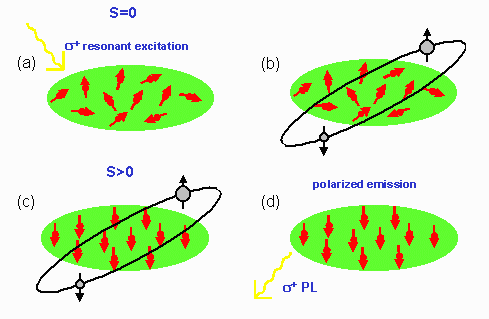
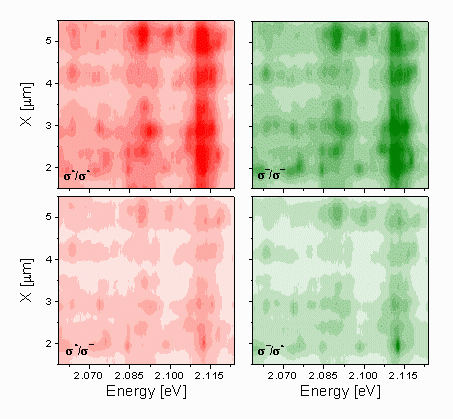
Publications:
S. Mackowski, T. Gurung, H.E. Jackson,
L.M. Smith, J. Kossut, G. Karczewski, "Exciton-controlled Magnetization
in Single Magnetic Quantum Dots", accepted for publication in the Applied
Physics Letters (2005)
S. Mackowski, T. Gurung, H.E. Jackson,
L.M. Smith, J. Kossut, G. Karczewski, "Optically Induced Magnetization
of CdMnTe Quantum Dots", AIP Conference Proceedings 772, 1327 (2005)
T. Gurung, S. Mackowski, H.E. Jackson,
L.M. Smith, J. Kossut, G. Karczewski, "Optical Studies of Zero-Field Magnetization
of CdMnTe Quantum Dots: Influence of Average Size and Composition of Quantum
Dots", Journal of Applied Physics 96, 7407 (2004)
S. Mackowski, T. Gurung, T.A. Nguyen,
H.E. Jackson, L.M. Smith, G. Karczewski, J. Kossut, "Optically-induced
Magnetization of
CdMnTe Self-Assembled Quantum Dots",
Applied Physics Letters 84, 3337 (2004)
S. Mackowski, T. Gurung, T.A. Nguyen,
K.P. Hewaparakrama, H.E. Jackson, L.M. Smith, J. Wrobel, K. Fronc, J. Kossut,
G. Karczewski, "Optical Studies of Spin Relaxation in CdTe Self-Assembled
Quantum Dots", physica status solidi c 1, 767 (2004)
S. Mackowski, T. Gurung, T.A. Nguyen,
H.E. Jackson, L.M. Smith, J. Kossut, G. Karczewski, "Optically Controlled
Magnetization of Zero-Dimensional Magnetic Polarons in CdMnTe Self-Assembled
Quantum Dots", physica status solidi b 241, 656 (2004)
A number of experimental methods, mainly based on time resolved spectroscopy, have been proposed to study exciton spin dynamics in quantum dots. We have developed a continuous wave experiment that allows to determine the exciton spin relaxation time. It is based on analyzing the polarization of QD emission when exciting quasi-resonant with polarized laser. At zero magnetic field we do not observe any net circular polarization of the emission (Fig. 4). Since more than 20% of all the dots in the ensemble feature negligible (<20meV) exchange splitting, we interpret this result as an evidence for extremely fast spin relaxation for QDs with degenerate exciton levels.
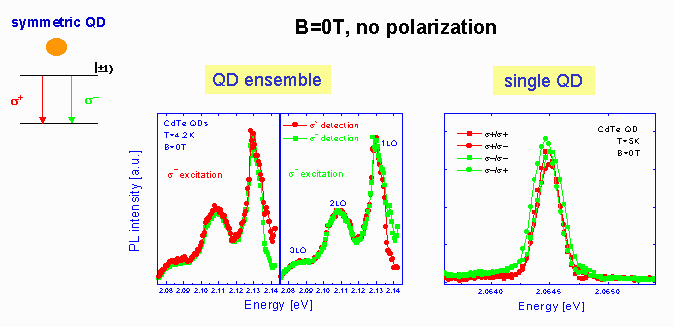
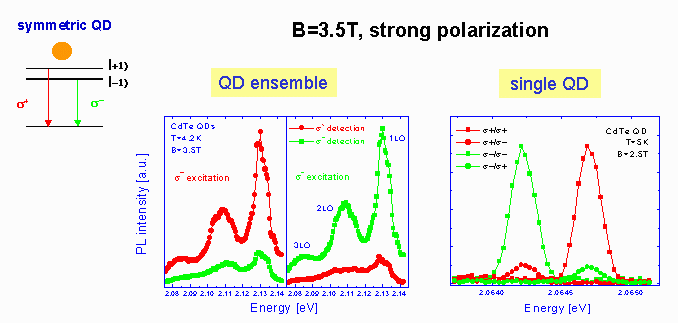

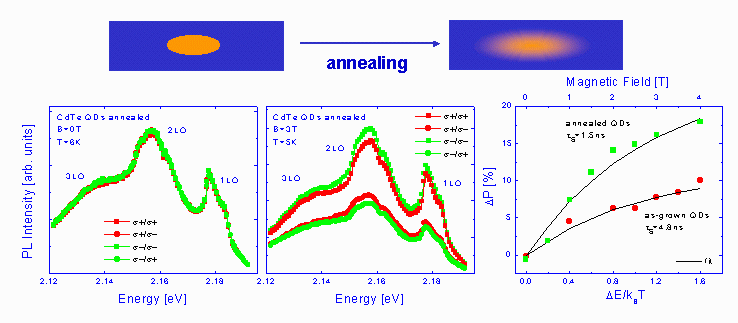

Publications:
S. Mackowski, T. Gurung, H.E. Jackson,
L.M. Smith, W. Heiss, J. Kossut, G. Karczewski, "Sensitivity of Exciton
Spin Relaxation in Quantum Dots to Confining Potential", Applied Physics
Letters 86, 103101 (2005)
S. Mackowski, T. Gurung, T.A. Nguyen,
H.E. Jackson, L.M. Smith, G. Karczewski, J. Kossut, M. Dobrowolska, J.K.
Furdyna, "Exciton Spin Relaxation in Symmetric Self-Assembled Quantum Dots",
AIP Conference Proceedings 772, 1357 (2005)
S. Mackowski, T.A. Nguyen, T. Gurung,
K.P. Hewaparakrama, H.E. Jackson, L.M. Smith, J. Wrobel, K. Fronc, J. Kossut,
G. Karczewski, "Exciton Spin Relaxation in Resonantly Excited CdTe/ZnTe
Self-Assembled Quantum Dots", Physical Review B 70, 245312 (2004)
S. Mackowski, T. Gurung, T.A. Nguyen,
K.P. Hewaparakrama, H.E. Jackson, L.M. Smith, J. Wrobel, K. Fronc, J. Kossut,
G. Karczewski, "Optical Studies of Spin Relaxation in CdTe Self-Assembled
Quantum Dots", physica status solidi c 1, 767 (2004)
S. Mackowski, T.A. Nguyen, H.E.
Jackson, L.M. Smith, J. Kossut, G. Karczewski, "Exciton Spin Relaxation
Time in Quantum Dots Measured by Continuous-Wave Photoluminescence Spectroscopy",
Applied Physics Letters 83, 5524 (2003)
S. Mackowski, L.M. Smith, H.E.
Jackson, W. Heiss, J. Kossut, G. Karczewski, "Optical Properties of Annealed
Self-Assembled CdTe Quantum Dots", Applied Physics Letters 83, 254
(2003)
Solid immersion lens (SIL), placed between the sample and a microscope objective increases the effective numerical aperture of the collection optics. The actual increase could be as large as the refractive index of SIL's material. We have developed a SIL-based optical experiment that enabled us to map single QDs with a spatial resolution down to 250nm. The schematics of the setup is shown in Fig. 9. We used a SIL made of LaSFN9 glass (n=1.83) and 50x microscope objective with NA of 0.5.


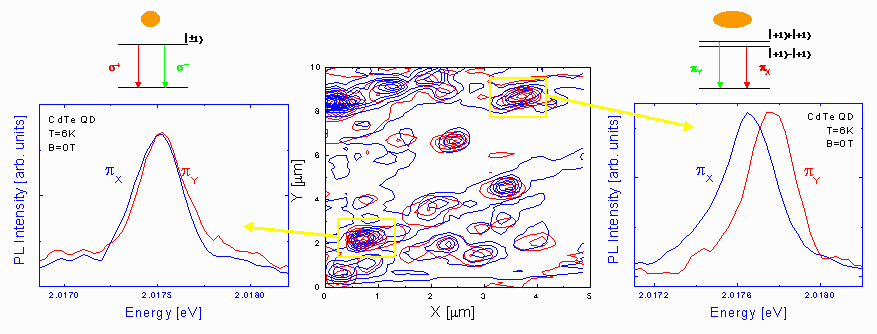
Publications:
K.P. Hewaparakrama, S. Mackowski,
H.E. Jackson, L.M. Smith, G. Karczewski, J. Kossut, "Photoluminescence
Imaging of CdTe/ZnTe Self-Assembled Quantum Dots", AIP Conference Proceedings
772,
711 (2005)
K.P. Hewaparakrama, A. Wilson,
S. Mackowski, H.E. Jackson, L.M. Smith, G. Karczewski, "Sub-Wavelength
Multi-Channel Imaging Using a Solid Immersion Lens: Spectroscopy of Excitons
in Single Quantum Dots", Applied Physics Letters 85, 5463 (2004)
Photolumienscence excitation (PLE) spectra of single CdTe QDs feature two types of excitations. The first one, which is usualy several meV broad and has relatively low intensity (see Fig. 12) is attributed to excitation into a virtual state mediated by exciton-LO phonon interaction. The second one (Fig. 12) is in contrast much more intense and significantly narrowed (typically less than 1 meV). Most certainly it is associated with a direct excited state-ground state excitation.
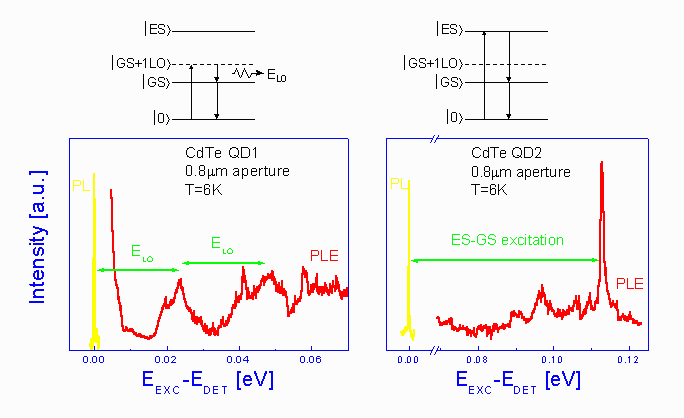

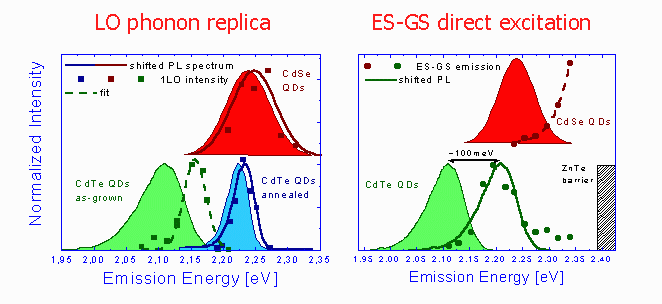
Publications:
T.A. Nguyen, S. Mackowski, H.E.
Jackson, L.M. Smith, M. Dobrowolska, J. Furdyna, K. Fronc, J. Wrobel, J.
Kossut, G. Karczewski, "Resonant Spectroscopy of II-VI Self-Assembled Quantum
Dots: Excited States and Exciton-LO Phonon Coupling", Physical Review B
70, 125306 (2004)
T.A. Nguyen, S. Mackowski, H.E.
Jackson, L.M. Smith, G. Karczewski, J. Kossut, M. Dobrowolska, J.K. Furdyna,
W. Heiss, "Exciton-LO Phonon Interaction in II-VI Self-Assembled Quantum
Dots", physica status solidi c 1, 937 (2004)
T.A. Nguyen, S. Mackowski, H. Rho,
L.M. Robinson, H.E. Jackson, L.M. Smith, S. Lee, M. Dobrowolska, J. Furdyna,
G. Karczewski, "Resonant and Non-Resonant Photoluminescence of CdSe/ZnSe
and CdTe/ZnTe Self-Assembled Quantum Dots", Proceedings of the 26th ICPS,
ed. A R Long and J H Davies, Edinburgh 2002, Institute of Physics Conference
Series 171, H157 (2003)
T.A. Nguyen, S. Mackowski, H. Rho,
H.E. Jackson, L.M. Smith, J. Wrobel, K. Fronc, J. Kossut, G. Karczewski,
M. Dobrowolska, J. Furdyna, "Resonant Photoluminescence Spectroscopy of
CdSe/ZnSe and CdTe/ZnTe Self-Assembled Quantum Dots", MRS Symposium Proceedings,
737,
E9.2.1 (2003)
We have studied the influence of rapid thermal annealing (RTA) on the optical and magnetic properties of self-assembled QDs. Similar pieces of samples were annealed fro 15 seconds in Argon atmosphere in temperatures ranging from 370C to 520C. In Fig. 15 we show low temperature micro-PL spectra obtained for samples containing CdTe QDs and CdMnTe QDs. In both these cases a strong blue-shift is observed, which is accompanied with narrowing of the inhomogeneous broadening of the PL emission.

In addtion, time-resolved experiments (Fig. 16) have revealed strong reduction of the exciton recombination time for annealed QD samples, which may be due to formation of non-radiative recombination centers as a result of annealing-induced interdiffusion. The reduction of emitting QDs in annealed samples is further confirmed by surprising observation of single dot emission lines when the sample annealed at 520C was excited with a laser spot of 30 microns in diameter (Fig. 16).

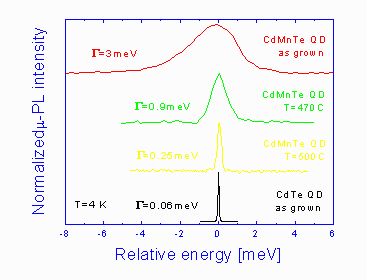
Publications:
T. Gurung, S. Mackowski, H.E. Jackson,
L.M. Smith, W. Heiss, J. Kossut, G. Karczewski, "Tuning the Optical and
Magnetic Properties of II-VI Quantum Dots by Post-Growth Rapid Thermal
Annealing", physica status solidi b 241, 652 (2004)
S. Mackowski, H.E. Jackson, L.M.
Smith, W. Heiss, J. Kossut, G. Karczewski, "Tuning the Properties of Magnetic
CdMnTe Quantum Dots", Applied Physics Letters 83, 3575 (2003)
S. Mackowski, L.M. Smith, H.E.
Jackson, W. Heiss, J. Kossut, G. Karczewski, "Optical Properties of Annealed
Self-Assembled CdTe Quantum Dots", Applied Physics Letters 83, 254
(2003)
S. Mackowski, T.A. Nguyen, H.E.
Jackson, L.M. Smith, G. Karczewski, J. Kossut, W. Heiss, "Optical Properties
of Semimagnetic Quantum Dots", MRS Symposium Proceedings, 737, E9.1.1
(2003)